Victoria, Whales, Plankton, and the Conference
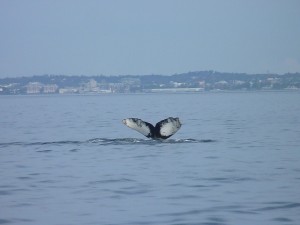
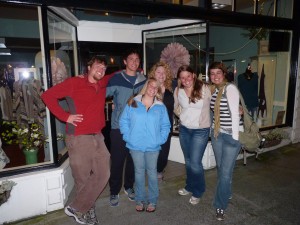


Our break on land was very useful because it gave everyone a chance to use the wireless internet, and get some things done. The first day back on the water was mostly spent traveling to Port Townsend because reports of whales came in from Puget Sound. Unfortunately, the whales decided to pass directly by where we were staying during the night, and we could even hear their blows despite not being able see them. Also there is a hydrophone installed at at the dock there, and it did an excellent job picking up calls from the whales as they pasted by in the dark. Some of the students took advantage of being on land by taking walks after dinner, and a few even took a cold shower in the morning (I wasn’t brave enough for the shower). During a walk Cat, Hana, and I found the old remains of what once was Fort Warden. This was very interesting stop, however, the next day was spent fighting a extremely strong current to get back to San Juan Island and the whales. It was a good day for everyone to work on their projects because of the long trip. Going North payed off and we found the whales, and in the process we made it close to Cherry Point and Bellingham, which is my hometown, so that was fun so see it from the water. One day when we were with the whales near Victoria we witnessed close to 20 spy hops and whales breaching left and right; this resulted in some excellent pictures and videos.
The group also celebrated our second and third birthdays on the boat with some delicious dinners, and whale shaped cake, and a cheesecake. The birthdays helped pass the days that we didn’t see many whales. For 10/10/10 we decided to write an editorial as a group to advocate for people to make a small sustainable change in their day to day lives. 10/10/10 is an call to action for keeping the concentration of CO2 in the atmosphere to 350 ppm.
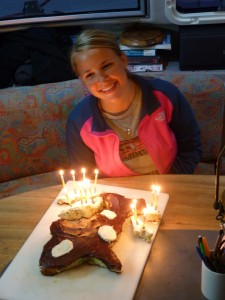
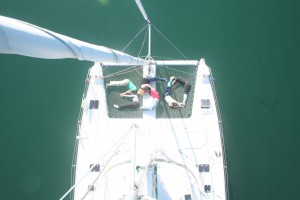
Everyone had strong opinions about this topic, and the group had some interesting discussions while we wrote the piece. On that Sunday Scott had everyone form the number for 350 with our bodies, and he was hoisted to the top of the mast with his camera for some really cool pictures. Now we are getting ready for a conference starting on Wednesday in Victoria Canada. Customs have cleared us in Rouche Harbor and we are planning on leaving bright and early tomorrow.
Read MoreI am going to start this blog by saying that sailing is definitely the ultimate way to get around. Thursday gave me a chance to try out my new orange rain gear (see the pictures), and it worked great. Megan, Cat, and I stayed on the deck for the entire time we were sailing, and we were all a little disappointed when the Captain made the decision to head in due to high winds; in Captain Todd’s defense it was the correct decision to keep us safe, and we appreciate and respect that. Todd also showed how much he trusts us by giving each person a turn at the helm for each type of sailing we encountered. It turns out staying on course is a lot harder while sailing down wind instead of up wind, and I feel like I learn a lot each time I take the wheel. We stayed North at Patos Island that night, and we had the little bay to all to ourselves except for a Harbor Seal that was eating a huge Chinook Salmon next to the boat. I used the time there to ask the Captain about his experiences with sailing, and it led to a very interesting conversation, and it ended with him lending me sailing magazines and recommending some really interesting books.
Today is our last day on the boat before our three day break on land to work on our preliminary data products. We are in Parks Bay and Jason just got done showing us the Beam Reach underwater video camera called the Critter Cam. It was great to see everyone hovering around a computer for well over a hour, in the cold night, getting excited over a bunch of shrimp, some crab, and even a few flounders. After tonight I know we will be using the Critter Cam again, and we will definitely post some video and pictures of what we find in the future. Until then I plan on using my legs as much as possible while I am on land, and enjoying the showers while they last.
Read MoreAfter cleaning and getting everything in order while at Friday Harbor we had the rare chance to sleep in the next morning before taking off again. Once we were back on the water we were lucky enough to finish our day with learning a new form of sailing which involved the screecher sail. aptain Todd is great teacher for sailing, and on Monday we were out on the west coast of San Juan Island clinging to the side of the boat in 20 knot winds learning how to deploy the mainsail and the jib. This was a perfect first day back on the boat, because it had a little bit of everything. We started the day with some amazing sailing in 2-4 foot waves; which didn’t agree with everyone on the boat unfortunately. After sailing for a few hours we found the whales, and the wind died enough to allow for the hydrophones to be deployed. Two sets of high quality recordings were made while we were surrounded by the whales, and the the amount of data we have is slowly getting bigger each day. We ended our night in Prevost Harbor, which gave everyone a chance to take a walk and stretch their legs. On the way to Prevost 5 or 6 Dall’s Porpoises began to bow ride on the boat, and they stayed there long enough for us to get some pictures of them underwater. This day was timed perfectly for the birthday of our professor Val, and on top of everything else that happened we celebrated his birthday with a delicious coffee cake after another great dinner.
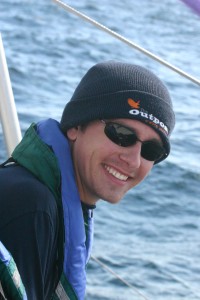
Tuesday brought another great day on the water. The Captain continued our boating education with a lecture on the tides in the Salish Sea. Tides are very important for navigating any type of boat, however the tides throughout the Salish Sea are especially strong, and they can be dangerous if you don’t know what you are doing. After our tide lecture we managed to find the whales again, and we stayed with them for most of the day. At first they were resting, which means they move slowly in a close group, and they don’t produce many sounds for us to record. This changed by the end of the day when the whales woke up from their nap, and we had a front row seat to watch them breaching, spyhopping, and socializing in general. Seeing the whales foraging and playing was a great way to end the day, and we then headed back to Prevost Harbor for a journal club discussion with an amazing sunset as the background.
Wednesday was definitely one of the best days we have had with the whales so far. We followed 30 or 40 whales, which is almost half of the entire southern resident population, while they were resting, and when they woke up it was amazing. We witnessed close to 30 breaches, countless tail slaps, and the whales continued to “play†for over an hour. I will remember this day forever and we have some great pictures to help share the experience.
This is my first blog entry so I am going to give an overview of my experiences and feelings for the first part of the fall beam reach program. I have had limited internet access while on the boat for the last week so this is my first chance to update everyone. I started the first week by getting to know the other students in the program, as well as getting use to our living situation while we are on land at the Friday Harbor Laboratories. One of the most interesting aspects from the beginning was discovering where each person is from and hearing stories about their previous experiences. Cat is the only student from the UK and a different country, and that has led to many funny conversations and explanations about differences in our cultures and words. We started to become a proper group by taking a series of walks along the trail system near the labs which lead to the shoreline of San Juan Island. While we were out there three of the girls in our group had their first experiences with marine wildlife in Northwest Washington, and this resulted in hundreds of pictures; mostly of tiny seal heads just above the water. The wildlife in the area is not limited to the marine environment, and we see deer and hawks on a daily basis; we were even lucky enough to see a fox (see picture). All these animals are associated with a 200 acre biological reserve that is adjacent to the labs, and that has given me a great place to go for a runs and walks.
The academic side of the program has been equally stimulating, and our professors have provided us with a crash course in acoustics, which includes how to use a series of hydrophones to record sounds made by killer whales for our research. In addition to our daily classes we were lucky enough to have outside guests come give lectures to our class about their personal research and experiences. On a couple of the nights we rowed into the town of Friday Harbor and enjoyed lectures from an octopus expert from the Seattle Aquarium, and Captain Paul Watson from the Sea Shepards at the local whale museum. Overall, the first three weeks on land were a great start for getting oriented to this type of program and living arrangement. However, now that we are on the boat everything has shifted again.
Each day on the boat has a rotation for various jobs which include cleaning up, and preparing breakfast, lunch, and dinner. I think the quality of the meals has surprised everyone, and each night has had a different delicious meal. We are lucky enough to have access to the 42 foot Gato Verde with Captain Todd Shuster. The Gato Verde is a 42 foot catamaran sail boat that is powered by a biodiesel generator, and an electric motor.  The electric motor produces extremely low levels of sound which allows us to take very accurate measurements of the whales while we are actively following them. Captain Todd has also been very helpful and effective at teaching everyone some essential knots, and techniques used for sailing, navigation, and operating the boat in a safely. As part of the course on sustainability we track our usage of electricity and water daily, and this has helped everyone realize how much each person uses in terms of resources on a daily basis. This is important information because the boat is a closed system with finite amounts of fresh water, food, fuel, and space for various forms of waste. Also we try to consume foods on lower trophic levels by staying with a vegetarian diet in order to further reduce our impact on the environment.
On a more exciting note we have encountered numerous marine species in our first week including Minke Whales, Harbor Seals, Stellar Sealions, River Otters, Tufted Puffins, Porpoises, and last but not least killer whales. We saw our first killer whales early in the week which resulted in a scramble to get some initial recordings which turned out to be amazing. It was a little difficult to follow them for as long as we would have liked due to heavy fog, however, we have had some very nice sunsets during dinner time for many of the days this week. On Wednesday we learned a valuable lesson when some of our batteries ran out and we lost some recordings for one of our hydrophones. Everyone on the boat has become more comfortable with equipment as the week progressed, and tonight is our first night on land in about a week. Everyone is busy taking showers and using the internet before we leave again tomorrow for another week of studying the whales. I am sure I will have many new and exciting stories by the end of next week to blog about, and I will post them as soon as I have a chance thanks for reading.
